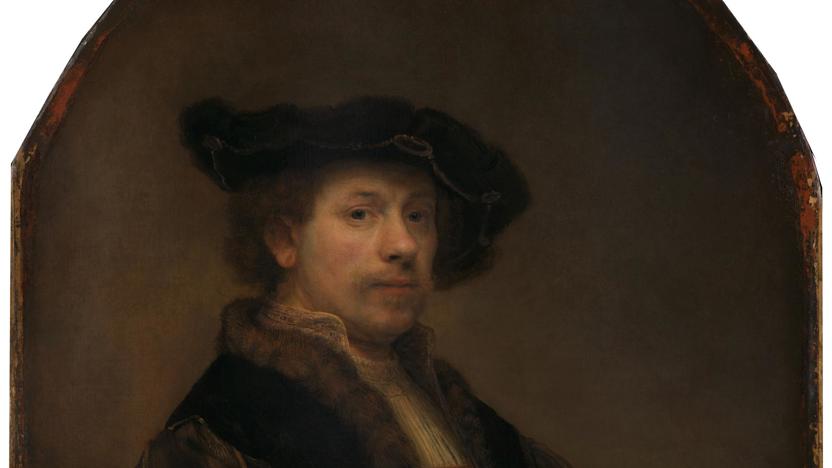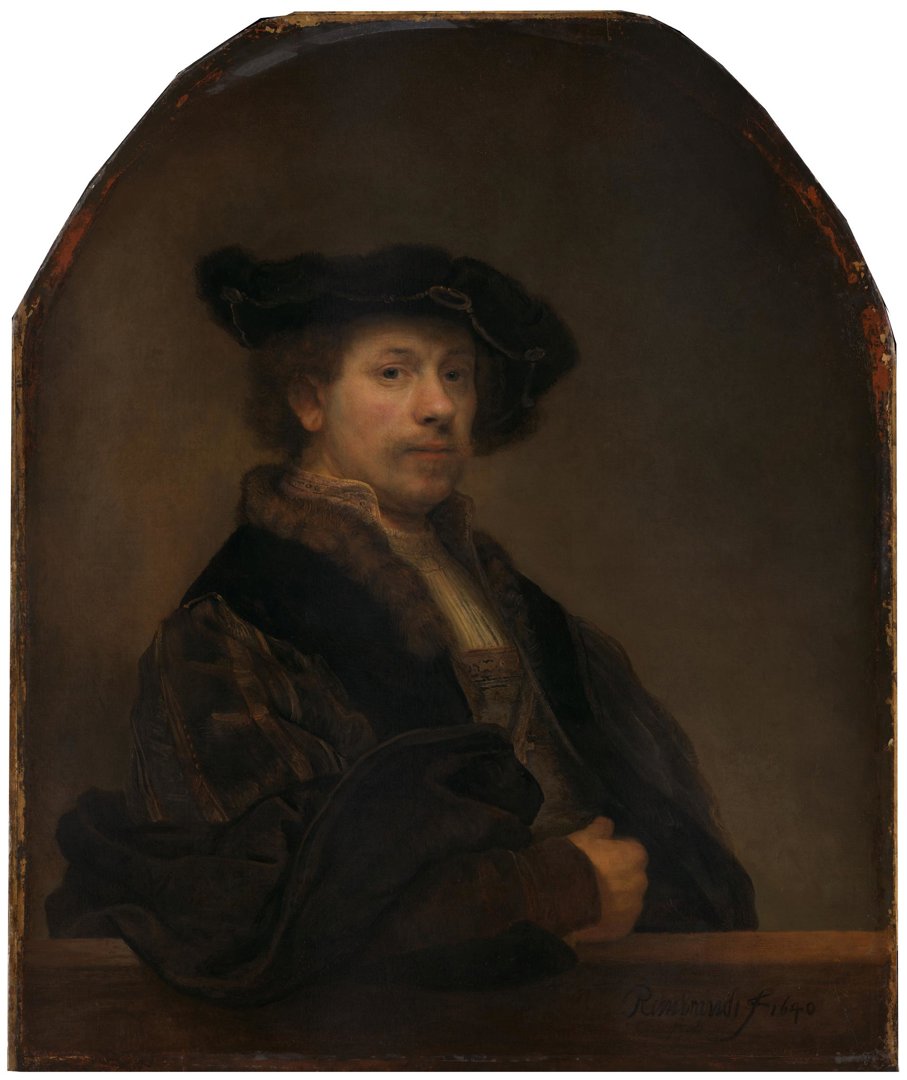Rembrandt's 'Self Portrait at the Age of 34'
Audio description
This is a description of Rembrandt’s Self Portrait at the Age of 34. It is oil on canvas and was painted in 1640. It is 90cm high and 75 wide. The work is presented in a gilt frame with a rounded arch at the top that encloses the painted figure. The Dutch master has depicted himself from the waist up, richly dressed and leaning on a stone ledge which runs along the bottom of the painting. His stocky body is turned to the right, but his head is angled towards us. His gaze is confident and direct. His left arm is hidden, but his right is placed firmly on the ledge, his elbow protruding towards us and his loosely clenched fist rests against his stomach. Rembrandt is clothed in velvet and fur and wears a shapely dark velvet hat with a flat top and a stiff, folded back brim. In this work, Rembrandt’s brushstrokes are smooth and meticulous. He predominantly uses brown, black and cream tones, creating a warm, atmospheric, and dimly lit painting. The source of light is defused through the painting, softly illuminating the artist from the right side of his face. His face is round and pale, with ruddy cheeks and wispy brown facial hair. He has a bulbus nose, intense dark grey eyes and red lips that are firmly pressed together. The Dutch artist pays careful attention to how the light illuminates his skin, showing us his imperfections and the early signs of aging. He created this self-portrait in Amsterdam, at a successful point in his career, when he was considered the go-to portraitist in The Netherlands. This work reflects his high status not only through his self-
assured, confident pose – which suggests that he is leaning towards us - but also through his choice of clothes. The folded back brim of his black velvet hat reveals fine embroidery detailing and decorative jewels. His tawny jacket appears heavy and expensive: it is trimmed with brown fur at the collar and has voluminous black velvet sleeves that finish at the elbow. Underneath this he wears a brown tunic and a white shirt with finely embroidered trim at the neckline. This style was no longer in fashion by the 1640s. Rembrandt has purposefully presented himself in fancy renaissance costume, a style prevalent more than a hundred years earlier. This is not the only reference to the past he has used. With this painting, Rembrandt is likening himself to famous artists of the past who painted similar self-portraits. One striking comparison is to a portrait painted 125 years earlier by Titian, one of the greatest Italian painters of the 16th century. Rembrandt had most likely seen his work, or possibly a close copy of it, in a private collection in Amsterdam. He has borrowed several elements for his own painting. He copied the composition with the arm on the ledge, and the sleeves of their garments are similar. Both are big and dramatic and both portraits ended up at the National Gallery in London, which is a wonderful coincidence. Although there are similarities, there are also important differences between the works. Titian’s garments are a shiny, pastel blue silk and the man in the portrait is well-lit. Rembrandt on the other hand, chose
brown tones and a softer light – adding depth to his image. Rembrandt made many studies and portraits of himself throughout his career, in etchings, drawings and paintings. He used his self-portraits to publicly establish his image as a successful artist and a recognisable figure, solidifying his reputation during his lifetime, and after his death. This self-portrait is considered a high point in his style of work. In choosing this pose and the 16th-century dress, Rembrandt was aligning himself to the past and its famous artists. His appearance in this painting has often been described as confident, and some have even called it arrogant. Others have praised its qualities of complete calmness. With this impressive painting, Rembrandt actively places himself in an artistic tradition of “the greats”, and that might just summarise the vibe of this self-portrait: we are in the presence of one of the greats... and boy, does he know it.


